BBQ Beef Brisket recipes excel with the right cut (flat or point), slow cooking at 225°F-250°F, using specific woods, and a rest period. Seasoning techniques, whether marinades or rubs, enhance flavor. Proper temperature control and resting ensure tender, juicy results. Present your brisket artfully with separate serving options and sauces for a memorable BBQ experience.
Unleash your inner BBQ master with our comprehensive guide to cooking the perfect BBQ Beef Brisket Recipe. From understanding the meat’s unique cut types and texture, to mastering the art of seasoning with marinades and rubs, this article covers all aspects of brining your brisket to amazing results. Learn the science behind smoking techniques, temperature control, and slow-cooking methods for tender, juicy meat. Discover the importance of the resting period and our expert slicing tips to serve a masterpiece that will have your folks begging for more.
- Understanding Brisket: Cut Types and Texture
- The Art of Seasoning: Marinades and Rubs for Flavor
- Smoking 101: Choosing the Right Wood and Temperature Control
- Slow and Steady Win the Race: Cooking Techniques for Tender Brisket
- Mastering the Resting Period: Why It's Crucial for Maximum Tenderness
- Slicing and Serving Tips: How to Present Your Perfect Brisket
Understanding Brisket: Cut Types and Texture
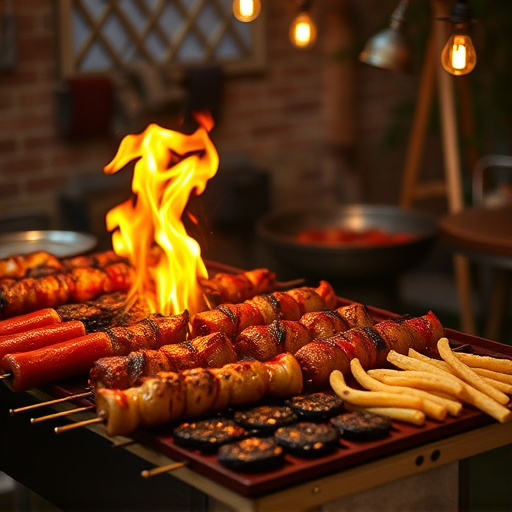
Brisket, a cut of beef from the breast or chuck area, is renowned for its exceptional flavor and tenderness when cooked low and slow—perfect for BBQ Beef Brisket Recipes. Understanding different brisket cuts and their unique textures is key to achieving amazing results. The most common cuts include flat and point. The flat, located on the leaner side of the brisket, remains relatively thin after trimming and cooks quickly. In contrast, the point retains more fat, making it marjorly fattier but taking longer to cook due to its larger muscle mass and thicker texture.
Textured variations within each cut also play a role in cooking. Brisket’s exterior may appear tough, but with slow, moist heat, it tenderizes beautifully. The interior is where the magic happens—converting from tough to delectable, melt-in-your-mouth meat. Properly prepared brisket should be incredibly juicy and have a rich, smoky flavor that will impress any BBQ enthusiast.
The Art of Seasoning: Marinades and Rubs for Flavor
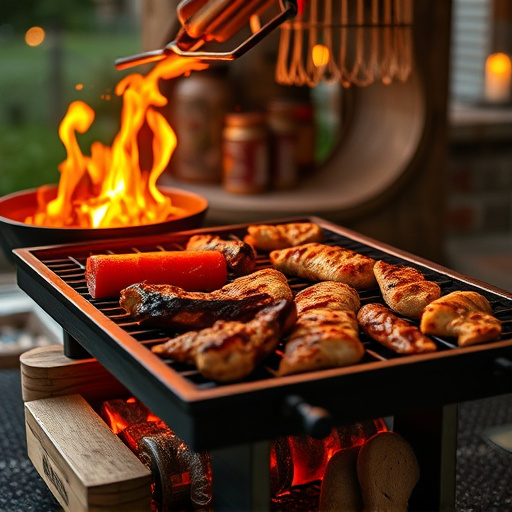
The secret to unlocking the full potential of your BBQ beef brisket recipe lies in the art of seasoning. Seasoning is more than just salt and pepper; it’s a complex dance of flavors that can transform an ordinary cut of meat into a masterpiece. Marinades and rubs are two powerful tools in the culinary arsenal when it comes to brining brisket to life.
Marinades, with their combination of acids, oils, and spices, penetrate the meat, tenderizing it and infusing it with a burst of flavor. Acids like lemon juice or vinegar break down proteins, while oils create a barrier that helps keep the meat moist during slow cooking. Spices such as garlic, paprika, and black pepper add depth and complexity, ensuring every bite is an explosion of deliciousness. Rubs, on the other hand, are dry seasonings applied directly to the surface of the brisket. These blends of spices stick to the meat, providing a crunchy texture and intensifying the flavor profile. A well-crafted rub can create a delectable crust, adding a satisfying crunch that contrasts with the tender, juicy interior of the brisket.
Smoking 101: Choosing the Right Wood and Temperature Control
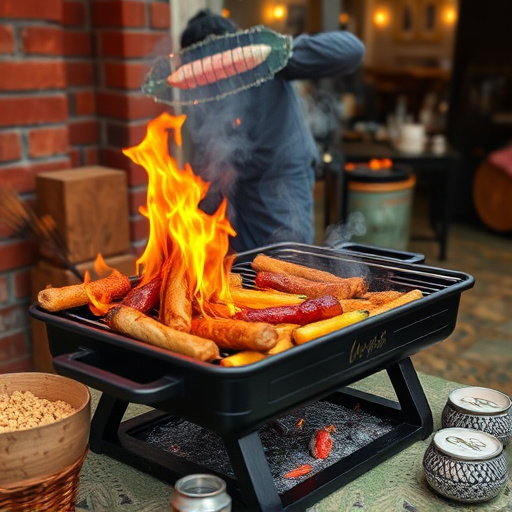
Smoking 101: Choosing the Right Wood and Temperature Control
When it comes to smoking BBQ beef brisket, selecting the perfect wood is key to unlocking that smoky, savory flavor. Different woods impart distinct aromas—hickory, oak, mesquite, and applewood are popular choices—each contributing unique nuances to your dish. For a classic barbecue taste, hickory and mesquite are go-to options, offering a robust and slightly spicy profile. Oak, on the other hand, imparts a milder, sweeter flavor that complements brisket nicely. Consider your desired outcome: a richer, spicier kick or a more subtle, sweet note.
Temperature control is another critical aspect of brisket smoking. The goal is to cook it slowly and evenly, allowing the meat to stay moist and tender. Typically, you’ll want to maintain a consistent temperature between 225°F (107°C) and 250°F (121°C). This slow cooking process breaks down connective tissues, resulting in that melt-in-your-mouth texture. Regularly monitor your smoker’s temperature using a reliable thermometer to ensure it stays within this ideal range throughout the entire cooking process, leading to an unforgettable BBQ beef brisket recipe.
Slow and Steady Win the Race: Cooking Techniques for Tender Brisket
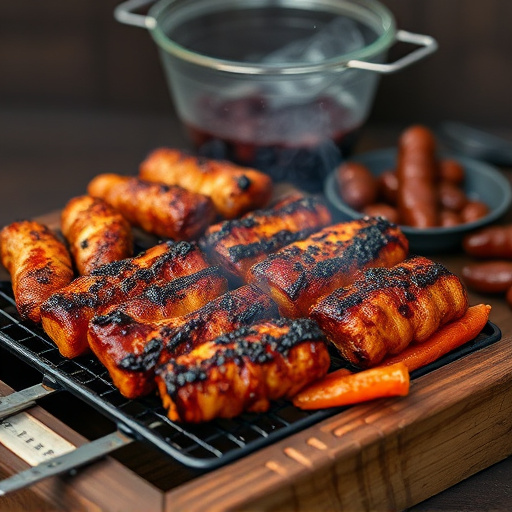
In the quest for mouthwatering BBQ beef brisket, understanding the art of slow and steady cooking is paramount. This method, often overlooked, ensures that the meat locks in its juices, resulting in a tender, succulent final product. Unlike quicker cooking techniques that can lead to dry, tough brisket, taking your time allows collagen in the meat to slowly break down into gelatin, making it incredibly juicy and flavorful.
Whether you’re following a classic BBQ beef brisket recipe or experimenting with your own, maintaining a consistent low temperature is key. Slow cooking lets you achieve this without overcooking the exterior. The goal is to cook the brisket until it becomes tender enough to shred easily with a fork. This process can take several hours, but for BBQ enthusiasts, the taste and texture of a perfectly slow-cooked brisket are well worth the wait.
Mastering the Resting Period: Why It's Crucial for Maximum Tenderness
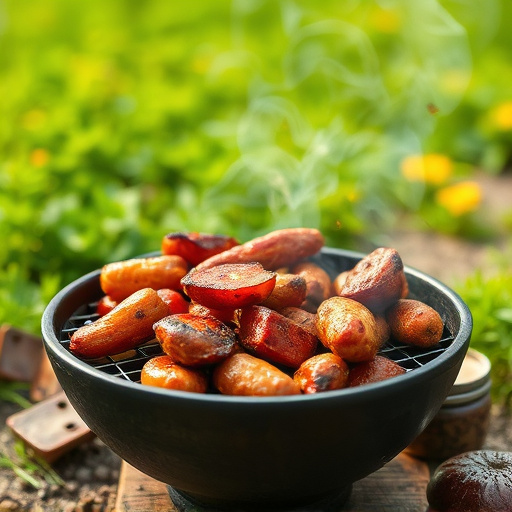
Mastering the resting period is a critical step in achieving tender and juicy BBQ beef brisket, making it an essential part of any successful BBQ beef brisket recipe. After slow-cooking your brisket to perfection, allowing it to rest for 1-2 hours before slicing ensures that the juices remain evenly distributed throughout the meat. During this time, the internal temperature of the brisket gradually decreases, enabling the collagen in the meat to transform into gelatin. This natural process helps to keep the brisket moist and incredibly tender when sliced, enhancing the overall flavor and texture.
Skimping on the resting period can result in a dry and tough brisket, as cutting into it too soon causes the juices to escape, leaving behind a less-than-desirable final product. So, be patient and let your hard work pay off by allowing the brisket to rest, giving it time to reach its full potential and create an unforgettable BBQ experience for your taste buds.
Slicing and Serving Tips: How to Present Your Perfect Brisket

When it comes to slicing and serving your perfectly cooked BBQ beef brisket recipe, the presentation is just as important as the taste. Start by removing the point (the leaner, more tender tip) from the flat (the fattier side). This allows for two distinct cuts: a thin slice of point and thicker slices of flat. The point can be served as a tender, flavorful appetizer or used in sandwiches for a delicious bite.
For the flat, aim for even thickness to ensure uniform cooking and doneness. Crosshatching the brisket with a sharp knife before serving enhances its texture and allows sauces and seasonings to penetrate deeper. This simple step can elevate your BBQ beef brisket recipe from good to amazing. Finally, consider the side dishes and sauces that complement the brisket; whether it’s classic barbecue sauce, spicy chili powder, or a tangy vinegar-based dip, presenting your creation alongside these pairings will complete the dining experience.
